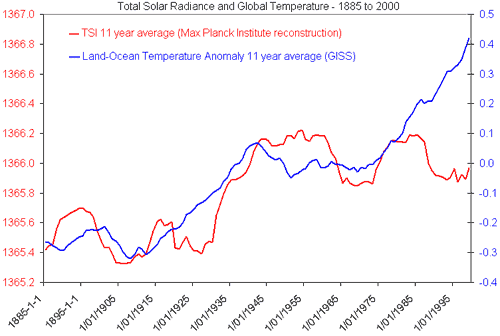It looks like you're using an Ad Blocker.
Please white-list or disable AboveTopSecret.com in your ad-blocking tool.
Thank you.
Some features of ATS will be disabled while you continue to use an ad-blocker.
share:
reply to post by Grimmley

If the entire solar system is warming why do Mercury and Venus maintain a regular temperature? If the sun were betting brighter or producing more heat surely the 2 planets closest to the sun would have gotten hotter.
Skeptical Science

If the entire solar system is warming why do Mercury and Venus maintain a regular temperature? If the sun were betting brighter or producing more heat surely the 2 planets closest to the sun would have gotten hotter.
The basis of this argument is that the sun must be causing global warming and in fact, warming throughout the solar system. There are several flaws in this line of thought. Firstly, the characterisation that the whole solar system is warming is erroneous. Around 6 planets or moons out of the more than 100 bodies in the solar system have been observed to be warming. On the other hand, Uranus is cooling (Young 2001).
Secondly, the theory that a brightening sun is causing global warming falls apart when you consider the sun has shown little to no trend since the 1950s. A variety of independent measurements of solar activity including satellite data, sunspot numbers, UV levels and solar magnetograms all paint a consistent picture. Over the last 35 years of global warming, sun and climate have been moving in opposite directions.
That begs the question - what is causing warming on other planets? With the exception of Pluto, climate change on other planets are fairly understood:
Martian climate is primarily driven by dust and albedo. Global dust storms increase the surface albedo by settling brighter dust on dark surfaces. Higher albedo leads to more sunlight being reflected which has a cooling effect. Snapshots of Mars' surface in 1977 and 1999 find that the surface was brighter in 1977 and darker in 1999. However, this doesn't necessarily point to a long term warming trend - the 1977 snapshot was made shortly after a global dust storm while the 1999 snapshot occured before a dust storm. Consequently, there is little empirical evidence that long term global warming on Mars is occuring (Richardson 2007). More on Mars...
Neptune's orbit is 164 years so observations (1950 to present day) span less than a third of a Neptunian year. Climate modelling of Neptune suggests its brightening is a seasonal response (Sromovsky 2003). Eg - Neptune's southern hemisphere is heading into summer. More on Neptune...
Neptune's largest moon, Triton, has warmed since the Voyager space probe visited it in 1989. The moon is approaching an extreme southern summer, a season that occurs every few hundred years. During this special time, the moon's southern hemisphere receives more direct sunlight (Elliot 1998).
Jupiter's storms are fueled by the planet's own internal heat (sunlight is 4% the level of solar energy at Earth). When several storms merge into one large storm (eg - Red Spot Jr), the planet loses its ability to mix heat, causing warming at the equator and cooling at the poles (Marcus 2006). More on Jupiter...
Pluto's warming is not clearly understood. Pluto's orbit is much more elliptical than that of the other planets, and its rotational axis is tipped by a large angle relative to its orbit. Both factors could contribute to drastic seasonal changes. As Pluto's orbit is equivalent to 248 Earth years and observed warming spans only 14 years, it is likely this is a seasonal response (Sromovsky 2003).
Skeptical Science
July 31, 2017
And now it's happening in Russia. CNBC says that global warming is causing the Permafrost to melt at an alarming rate!
www.cnbc.com...
And now it's happening in Russia. CNBC says that global warming is causing the Permafrost to melt at an alarming rate!
www.cnbc.com...
new topics
-
Elon Says It’s ‘Likely’ He Buys Tanking MSNBC
Political Ideology: 55 minutes ago -
Montelukast affects brain, caused 5 year old to attempt suicide
Medical Issues & Conspiracies: 1 hours ago -
Jaguar Rebrand Video Causes "WTF?" Moment - Seriously Weird
Automotive Discussion: 3 hours ago -
Let's start a conspiracy
General Conspiracies: 4 hours ago -
What Joe Rogan said Vs The View
Dissecting Disinformation: 7 hours ago -
Biden's "Reckless" Decision To Escalate Russia-Ukraine War
World War Three: 8 hours ago
